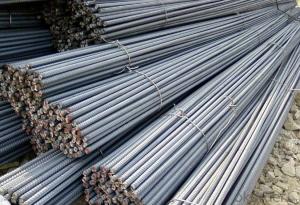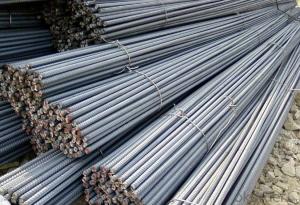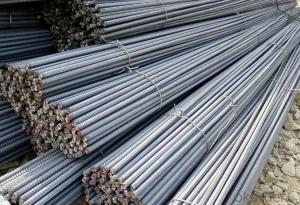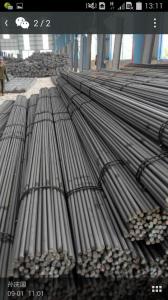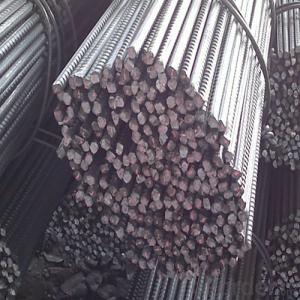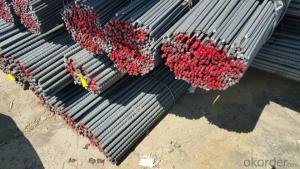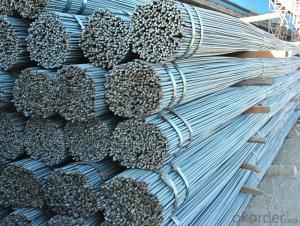Hot rolled deformed bar BS4449 G460B HRB400
- Loading Port:
- Tianjin
- Payment Terms:
- TT OR LC
- Min Order Qty:
- 25 m.t.
- Supply Capability:
- 20000000 m.t./month
OKorder Service Pledge
OKorder Financial Service
You Might Also Like
Deformed Bar Details:
| Minimum Order Quantity: | m.t. | Unit: | m.t. | Loading Port: | |
| Supply Ability: | m.t./month | Payment Terms: | TT OR LC | Package: | wire rod packing |
Product Description:
Product Description:
Specifications of HRB400 Deformed Steel Bar:
Standard | GB | HRB400 | |
Diameter | 6mm,8mm,10mm,12mm,14mm,16mm,18mm,20mm, 22mm,25mm,28mm,32mm,36mm,40mm,50mm | ||
Length | 6M, 9M,12M or as required | ||
Place of origin | Hebei, China mainland | ||
Advantages | exact size, regular package, chemical and mechanical properties are stable. | ||
Type | Hot rolled deformed steel bar | ||
Brand name | DRAGON | ||
Chemical Composition: (Please kindly find our chemistry of our material based on HRB500 as below for your information)
Grade | Technical data of the original chemical composition (%) | ||||||
C | Mn | Si | S | P | V | ||
HRB400 | ≤0.25 | ≤1.60 | ≤0.80 | ≤0.045 | ≤0.045 | 0.04-0.12 | |
Physical capability | |||||||
Yield Strength (N/cm²) | Tensile Strength (N/cm²) | Elongation (%) | |||||
≥400 | ≥570 | ≥14 | |||||
Theoretical weight and section area of each diameter as below for your information:
Diameter(mm) | Section area (mm²) | Mass(kg/m) | Weight of 12m bar(kg) |
6 | 28.27 | 0.222 | 2.664 |
8 | 50.27 | 0.395 | 4.74 |
10 | 78.54 | 0.617 | 7.404 |
12 | 113.1 | 0.888 | 10.656 |
14 | 153.9 | 1.21 | 14.52 |
16 | 201.1 | 1.58 | 18.96 |
18 | 254.5 | 2.00 | 24 |
20 | 314.2 | 2.47 | 29.64 |
22 | 380.1 | 2.98 | 35.76 |
25 | 490.9 | 3.85 | 46.2 |
28 | 615.8 | 4.83 | 57.96 |
32 | 804.2 | 6.31 | 75.72 |
36 | 1018 | 7.99 | 98.88 |
40 | 1257 | 9.87 | 118.44 |
50 | 1964 | 15.42 | 185.04 |
Usage and Applications of HRB400 Deformed Steel Bar:
Deformed bar is widely used in buildings, bridges, roads and other engineering construction. Big to highways, railways, bridges, culverts, tunnels, public facilities such as flood control, dam, small to housing construction, beam, column, wall and the foundation of the plate, deformed bar is an integral structure material. With the development of world economy and the vigorous development of infrastructure construction, real estate, the demand for deformed bar will be larger and larger..
Packaging & Delivery of HRB400 Deformed Steel Bar:
Packaging Detail: products are packed in bundle and then shipped by container or bulk vessel, deformed bar is usually naked strapping delivery, when storing, please pay attention to moisture proof. The performance of rust will produce adverse effect.
Each bundle weight: 2-3MT, or as required
Payment term: TT or L/C
Delivery Detail: within 45 days after received advanced payment or LC.
Label: to be specified by customer, generally, each bundle has 1-2 labels
Trade terms: FOB, CFR, CIF
- Q: What is the process of inspecting steel rebars before installation?
- The process of inspecting steel rebars before installation typically involves visual examination, measurement, and testing. The rebars are visually inspected for any visible defects such as cracks, rust, or bending. Measurements are taken to ensure the rebars meet the required dimensions, length, and diameter specified in the design. Additionally, non-destructive testing methods like ultrasonic testing or magnetic particle inspection may be performed to detect any hidden defects or irregularities. This thorough inspection process helps ensure the quality and integrity of the rebars before they are installed in construction projects.
- Q: How do steel rebars affect the overall weight of a concrete structure?
- Steel rebars typically increase the overall weight of a concrete structure. This is because steel rebars add additional mass to the concrete, making it heavier. However, the weight increase is generally proportionate to the added strength and durability that the rebars provide, making them essential for reinforcing the structure and improving its structural integrity.
- Q: Can steel rebars be used in concrete columns?
- Yes, steel rebars can be used in concrete columns. In fact, steel rebars are commonly used as reinforcement in concrete structures, including columns. The primary purpose of using rebars in concrete columns is to enhance their strength and durability. The rebars are embedded within the concrete mixture, providing additional tensile strength to the structure. This helps to prevent cracking and failure of the columns under various loads and forces. The use of steel rebars in concrete columns is a widely accepted practice in the construction industry and is essential in ensuring the structural integrity and longevity of the columns.
- Q: Are there any health and safety concerns related to steel rebars?
- Yes, there are potential health and safety concerns related to steel rebars. Handling and working with steel rebars can pose risks such as cuts, injuries from falling or displaced rebars, and musculoskeletal disorders due to heavy lifting or repetitive movements. Additionally, workers may be exposed to hazards during the fabrication process, such as welding fumes or noise pollution. Adequate safety measures, including personal protective equipment and proper training, should be implemented to mitigate these risks and ensure a safe working environment.
- Q: What are the guidelines for cutting and bending steel rebars on-site?
- To ensure safety and accuracy when cutting and bending steel rebars on-site, it is essential to adhere to specific guidelines. These guidelines play a crucial role in maintaining the structural integrity of the rebars. Here are some key considerations to keep in mind: 1. Prioritize safety: Before initiating any cutting or bending activities, it is imperative to prioritize safety. This involves wearing appropriate personal protective equipment (PPE) such as goggles, gloves, and steel-toe boots. Additionally, ensure that the work area is free from hazards and that all safety protocols are followed. 2. Utilize appropriate cutting tools: When cutting rebars, it is important to use high-quality cutting tools specifically designed for this purpose. Commonly used manual cutting tools include bolt cutters or hydraulic shears. It is crucial to ensure that the cutting tool is sharp and in good condition to achieve clean cuts. Avoid using torches or heat-based methods, as they can weaken the rebars. 3. Precise measurement and marking: Before cutting, it is essential to measure and mark the rebars accurately according to the required lengths. To ensure accuracy, utilize a measuring tape and a permanent marker. Double-check the measurements to avoid any mistakes that may result in wastage or improper reinforcement. 4. Employ proper bending tools: When bending rebars, it is vital to use appropriate bending tools or machines. These tools ensure accurate bending angles and minimize the risk of rebars breaking or cracking. Adhere to the bending specifications provided by the project engineer or local building codes to ensure compliance. 5. Familiarize with reinforcement requirements: Gain a thorough understanding of the reinforcement requirements by reviewing the project plans, drawings, and specifications. Different projects may have specific guidelines for cutting and bending rebars. It is crucial to adhere to these requirements to ensure correct installation and provide the necessary structural strength. 6. Maintain quality control: Regularly inspect the rebars during the cutting and bending process to verify that they meet the required standards. Look for any signs of damage, cracks, or substandard workmanship. Additionally, ensure that the rebars are appropriately sorted and stored to prevent mix-ups or confusion on-site. 7. Effective waste management: Implement proper waste management practices for the waste generated during the cutting and bending process. Collect and dispose of steel shavings or offcuts in designated containers to prevent injuries or accidents caused by sharp edges. In conclusion, adhering to these guidelines for cutting and bending steel rebars on-site will contribute to the safety, accuracy, and effectiveness of the reinforcement process. When in doubt or faced with specific project requirements, it is advisable to consult experienced professionals or the project engineer.
- Q: How are steel rebars connected or spliced together?
- Steel rebars are typically connected or spliced together using various methods, including lap splicing, mechanical splicing, and welded splicing. Lap splicing involves overlapping the rebars and tying them together using wire or steel ties. Mechanical splicing involves using couplers or connectors to join the rebars together, providing a strong and efficient connection. Welded splicing involves welding the rebars together, creating a permanent and robust connection. The choice of splicing method depends on factors such as project requirements, structural design, and construction techniques.
- Q: What is the resistance of steel rebars against acid attacks?
- Steel rebars have a high resistance against acid attacks due to the protective layer of rust that forms on their surface. This layer, known as iron oxide, acts as a barrier between the steel and the acid, preventing direct contact and corrosion. Additionally, the high carbon content in steel rebars enhances their resistance to acid attacks, as carbon forms a protective film that further shields the steel from acid damage. However, it is important to note that prolonged exposure to highly concentrated or corrosive acids may still lead to some degree of corrosion, albeit at a slower rate compared to other metals. Therefore, it is advisable to select the appropriate grade of steel rebar and provide additional protective measures, such as coatings or concrete cover, to ensure optimal resistance against acid attacks in specific applications.
- Q: What is the maximum allowable diameter for steel rebars?
- The maximum allowable diameter for steel rebars varies depending on the specific construction project and design specifications. However, commonly used steel rebars typically range from 6mm to 50mm in diameter.
- Q: Can steel rebars be used in tunnels or underground mines?
- Yes, steel rebars can be used in tunnels or underground mines. They are commonly used to reinforce the concrete structures in these environments, providing strength and stability to the tunnel or mine structure.
- Q: Are steel rebars suitable for high-rise buildings?
- High-rise buildings can benefit greatly from the use of steel rebars. These reinforcing bars, also known as steel rebars, are extensively utilized in the construction industry to add strength and stability to concrete structures. The robustness of high-rise buildings necessitates sturdy structural elements that can withstand the substantial loads and forces experienced at greater heights. Steel rebars are perfectly suited for this purpose due to their exceptional tensile strength, durability, and capacity to endure heavy loads. Utilizing steel rebars in high-rise buildings presents numerous advantages. Firstly, these rebars offer outstanding tensile strength, which is essential for counteracting the tensile forces that manifest in tall structures. By distributing the load evenly throughout the building, these rebars prevent the concrete from cracking or failing under pressure. Secondly, steel rebars possess remarkable durability, rendering them ideal for enduring the stresses and strains endured by high-rise buildings. They boast a lengthy lifespan and can withstand exposure to severe environmental conditions, including extreme temperatures, moisture, and corrosion. This durability ensures the building's longevity and safety. Furthermore, steel rebars can be easily fabricated and installed, enabling efficient construction processes in high-rise buildings. The adaptability and versatility of steel rebars make them suitable for various structural designs and configurations, empowering architects and engineers to create innovative and efficient building systems. Moreover, incorporating steel rebars in high-rise buildings enhances fire resistance. Owing to steel's high melting point, steel rebars can help prevent structural collapse in the event of a fire. This factor is crucial for occupant safety and the overall integrity of the building. In conclusion, steel rebars are undeniably suitable for high-rise buildings. Their exceptional tensile strength, durability, ease of fabrication, and fire resistance make them an excellent choice for providing structural stability and strength in tall structures. Utilizing steel rebars guarantees the safety, longevity, and dependability of high-rise buildings.
Send your message to us
Hot rolled deformed bar BS4449 G460B HRB400
- Loading Port:
- Tianjin
- Payment Terms:
- TT OR LC
- Min Order Qty:
- 25 m.t.
- Supply Capability:
- 20000000 m.t./month
OKorder Service Pledge
OKorder Financial Service
Similar products
Hot products
Hot Searches
Related keywords
